
Why a Client Portal is Essential for Your Business Success
- 7 Min read
Modern customers are lazy, picky and demanding. They expect businesses to fight for them, and indeed, businesses fight. Why does this happen? Well, the markets are over-saturated with choices. Access to information is so easy a 5-year kid can find almost anything on the net. The boom in technology allows businesses to elevate customer care to unprecedented heights. The simple truth is customer expectations are ever-growing and businesses are at pains to meet those—it seems to be a Sisyphean task.
Time for some statistics. 70% of customers decide whether to buy a product or service based on how good the brand’s customer service is. Stunning, right? This means previously overlooked business aspects like customer experience and customer success are getting more and more important today. Nowadays just having a product or service alone is not enough; you need to make sure your customers are satisfied and have a smooth journey with your company.
This article focuses on the client or customer satisfaction aspect of customer satisfaction. We will define what this looks like, explore its benefits and try to identify the best software tools for successfully onboarding clients.
If you’re striving to improve your customer retention and loyalty, enhance customer engagement, boost user activation rates and encourage the use of your product or service, this article is what you need.
The article describes and lists products in two categories.
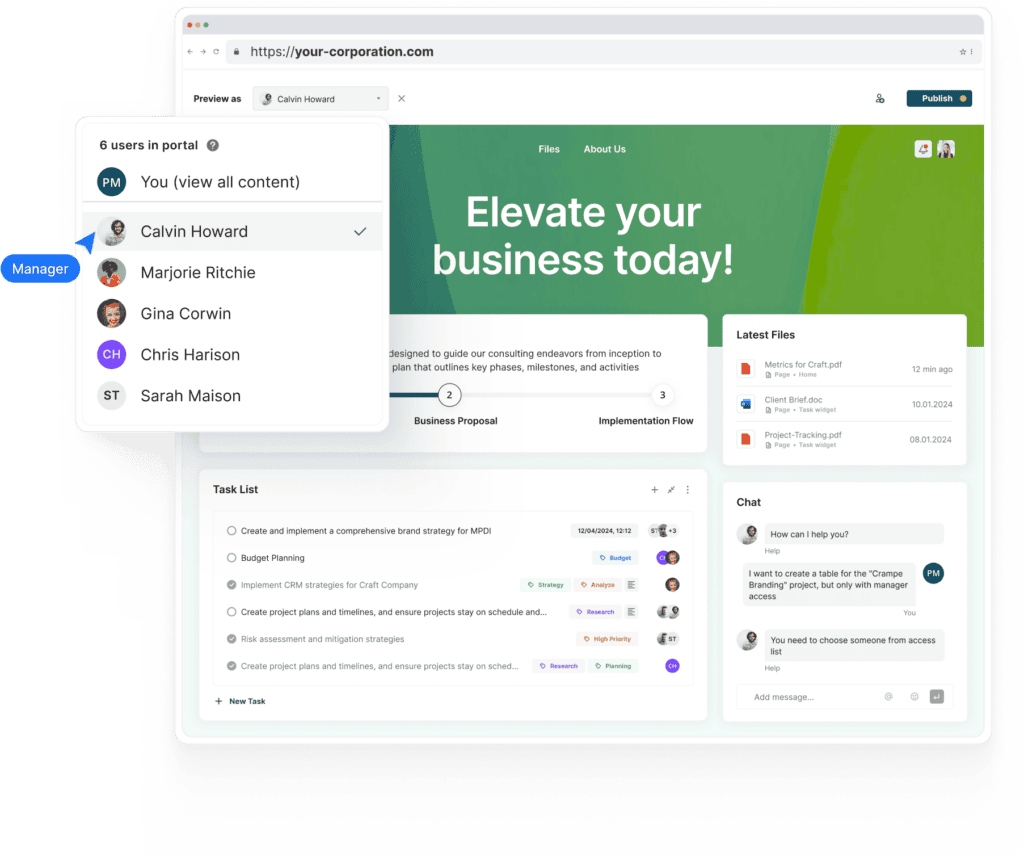
The process of incorporating clients into a business, known as client or customer onboarding, aims to establish lasting and fruitful relationships. Of course, primarily customer onboarding involves welcoming customers as they start their journey with a product or service. This may include providing customers with the necessary assistance, information and resources to help them effectively use the tool.
We have already mentioned modern customers are lazy and have high expectations. In particular, they expect businesses will teach them not only how to use a product or service but also how to benefit from it.
So, what are the typical client onboarding activities? These mainly include creating all kinds of tutorials and knowledge bases, troubleshooting any issues, conducting follow-ups, gathering feedback, etc. The results of effective customer onboarding are quite impressive: lower customer turnover rates, reduced customer support costs and increased chances of retaining customers.
Therefore, if your company doesn’t yet have an established user onboarding process, it’s high time to consider implementing one without delay.
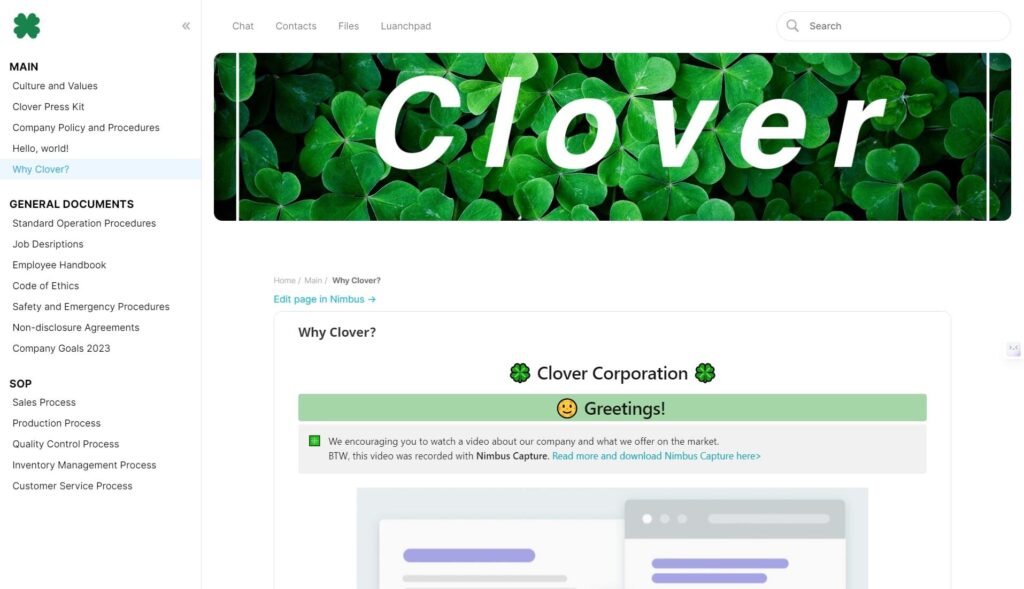
Listen to your clients’ needs and try to adjust to their requirements. By providing tailored customer approaches, you show you value your customers and are committed to their satisfaction.
Keep your communication with clients transparent right from the beginning. The more clear you are, the better. Your new clients need to understand what to anticipate from interaction with your business at every stage.
Customer education lies at the core of successful customer onboarding. It is important to provide training and share resources to help clients become proficient in using your product or service. The more complex your offering is, the more comprehensive customer education should be: prepare tutorials, FAQs, knowledge bases, client portals, guides, documentation – anything that can facilitate customer learning.
Motivate clients to share their thoughts and suggestions about both the client onboarding process and the product or service. Next, encourage your customer success team to use this customer feedback to improve the customer journey for future customers.
To better understand the effectiveness of your onboarding activities, you need to define and monitor key performance indicators (KPIs) such as time to value, product usage, client success and retention rates.
It might be a good idea to celebrate clients’ achievements and milestones reached during the customer onboarding process. This should form a bond between a brand and a customer and promote a sense of engagement in the latter.
Why not take the advantage of client onboarding tools and digital adoption platforms? They can simplify your administrative tasks and equip clients with customer self-service options, allowing them to access required information and manage their onboarding journey on their own.
Let us now look at client onboarding software in more detail.
Now that we know a little more about client onboarding, let’s move on to the examples. If you work in a B2B company or provide a service that needs to not only deliver content but also interact and communicate with clients at every stage of a project, then we have something for you! We’ve compiled the best of the best client onboarding software platforms. We’ll explore the features, benefits, and pricing of each.
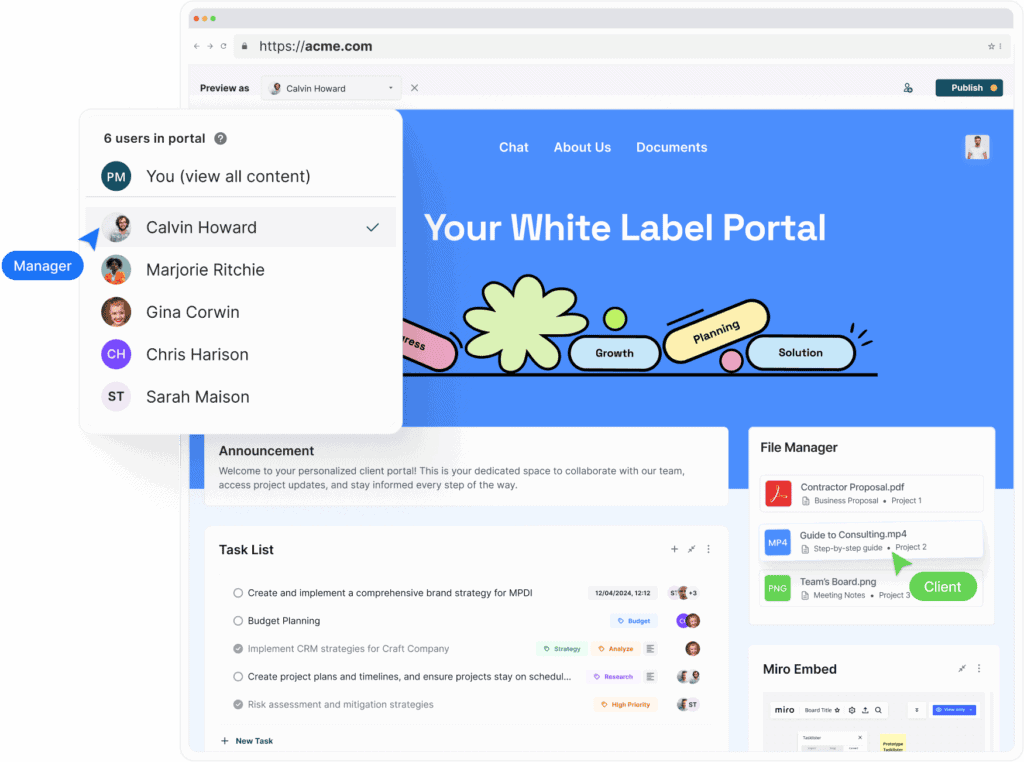
FuseBase ranks number one on our list of the best client onboarding software. And there are good reasons for this. This no-code solution is like a Swiss knife in your toolkit – a versatile tool capable of nearly anything.
FuseBase started as a note-taking app that allowed for consolidating various types of content within one workspace – plain text, tables, databases, images, videos, files of any format, and so on. However, it quickly evolved into something much more than a simple personal information management tool. Today, FuseBase is a complex, all-in-one collaboration hub with powerful knowledge management, knowledge sharing, and client management features. It can be used as an effective solution for organizing various business processes within a company.
It’s also great for onboarding clients, and the list of its features below will explain why.
On a single page, you can gather various kinds of information such as text, images, audio, videos, PDFs, and other files. Rich navigation options – buttons, hints, and toggles – help product teams and clients navigate through the pages no matter how long or complex they are. The feature is ideal for creating a knowledge base, product tours, and support materials.
Your clients don’t need FuseBase accounts to access shared pages. More than that, there is no need for complex technical manipulations – just send a link. Ideal for user onboarding, right?
FuseBase allows creating client portals and populating them with the necessary information. A client portal is a place where you can keep all the project information, updates, and approvals. This way you can make sure your clients and product teams are on the same page.
Pricing: The Essential plan starts at$38/per team.
Free trial: Available.
Capterra rating: 4.6 (172 reviews).
G2 rating: 4.7 (101 reviews).
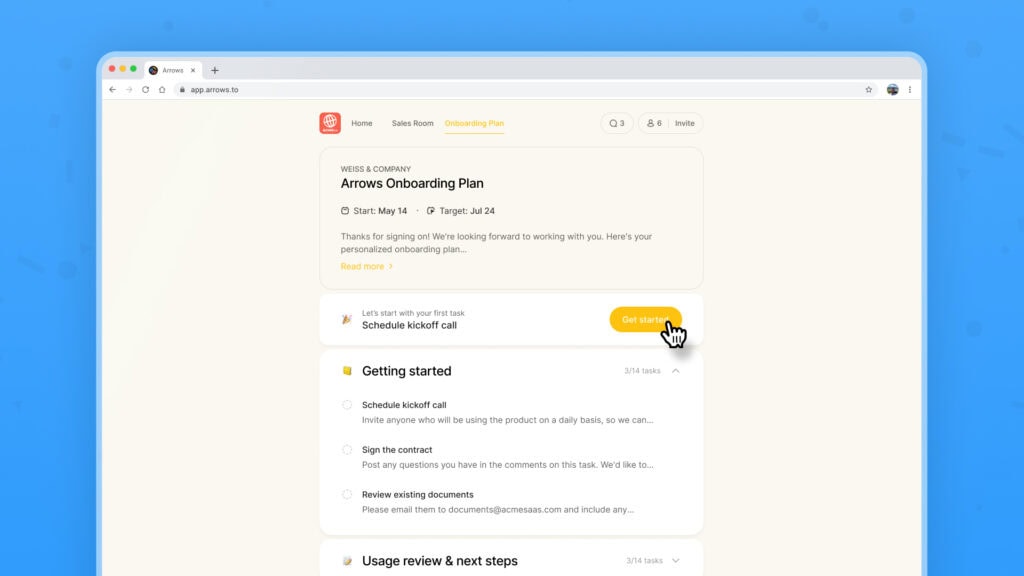
Arrows is mostly known to sales teams because it also offers other products, such as deal rooms, in addition to onboarding solutions. Arrows software helps you deliver perfectly tailored onboarding experiences that adapt to each client’s needs. It allows you to create the client-facing set of steps — collaborative onboarding plans — that attach to your HubSpot deals, tickets, or custom objects. Your team will have shared visibility into onboarding progress and insights, while clients will walk an easy-to-follow path to success with your product. A plan can include a set of questions a client needs to answer or a list of tasks a client needs to complete during the onboarding phase.
This software offers features for clear management such as guided task progression to ensure key steps are completed before moving forward and simple, bite-sized steps to break down complex processes into achievable tasks. That way you don’t overwhelm clients and give clear visibility on what’s next, helping keep everyone on track and aligned. You can even trigger customized email reminders and updates based on client actions, progress, and plan-specific conditions for better personalization.
If your company has a custom domain, logos, or brand colors, you can incorporate them to deliver a perfectly branded experience. This software allows you to host your onboarding plans on your own domain and send automated reminder emails from your domain for a professional touch. Great for showing your professionalism from the start.
Collect all onboarding files and data in one organized place. Give clients an easy way to fill out forms and upload files without the hassle of email attachments. Keep every document together, so you never have to search multiple channels for the information you need.
Pricing: Starts from $500/per month
Free trial: Available.
Capterra rating: –
G2 rating: 4.8 (47 reviews)
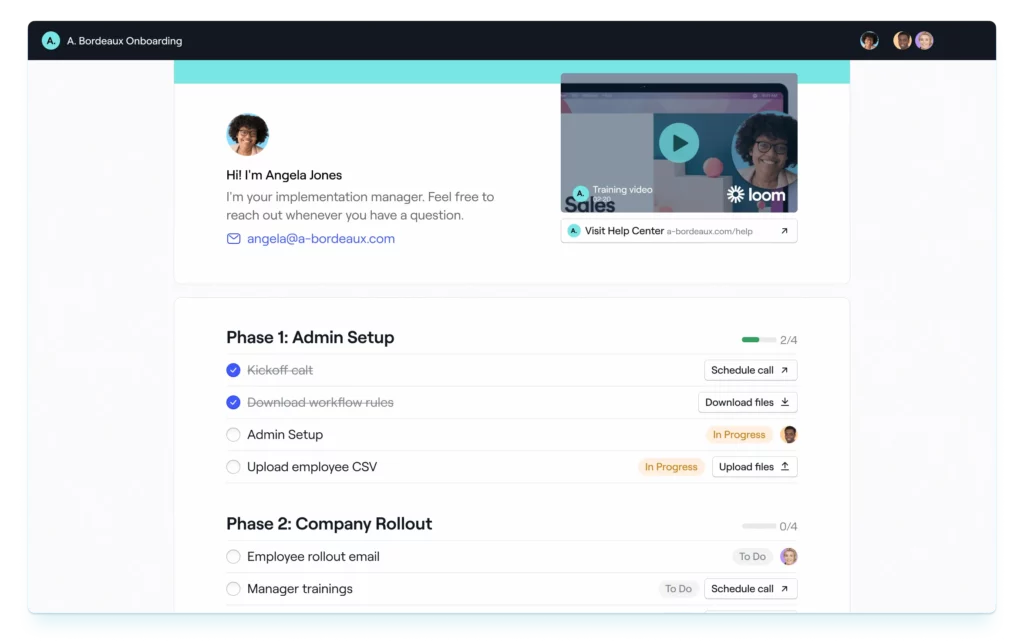
Dock.us is collaborative software for sales deals and client onboarding. Just like FuseBase, this platform allows you to create a hub for clear interactions and transparency at each onboarding step. You can create personalized, customizable client onboarding portals to share project plans, onboarding content, and forms in one collaborative space.
No need to create a workspace from scratch for each client. Dock provides a pre-designed blueprint for fast onboarding and allows the creation of company-wide onboarding templates. These templates can be copied and personalized in just a few clicks. And it’s not just portals – you can also create templates of success plans with phases, tasks, and due dates.
Onboarding is often slowed down by unnecessary emails and meetings. But Dock.us has a solution! You can organize your onboarding videos, articles, forms, etc. into a logical flow, and create checklists or Kanban boards with action buttons, embedded content, and due date notifications. This way, you give your clients one self-service resource hub so they can move through onboarding at their own pace.
Need to see which stakeholders are accessing the workspace, what they’re doing, and when? Dock.us has a feature for that too. You can track activity, contacts & content engagement, and see task progress, form submissions, and recent activity.
Pricing: Starts from $49/per person/per month. The free plan is also available.
Free trial: Available.
Capterra rating: –
G2 rating: 4.9 (119 reviews)
Customer onboarding software, also called client onboarding software, are specialized onboarding tools designed to simplify the process of integrating customers into your business ecosystem. These tools are useful at all stages of onboarding, from initial engagement to successfully adopting a product or service.
Customer onboarding software helps not only educate new customers but also significantly speed up their learning experience. The aim of onboarding software is to improve customer experience, reduce manual efforts on the side of a business owner, and ensure seamless customer integration.
In simple words, a customer onboarding solution is a tool that helps both a business and its client with the product adoption through integrations, demos, walkthroughs, training and more.
Customer onboarding tools are indispensable assistants for businesses that value their customers and strive to establish long-term relationships with them.
Let us inspect the best customer onboarding solutions available in the market today. Here are examples of products that can help with onboarding within your product. They can highlight relevant areas & pop-ups and help your user interact with your product correctly. We will explore features, analyze pros and cons, and take a closer look at pricing options.
Buckle up and get ready as we embark on our exploration of customer onboarding software.
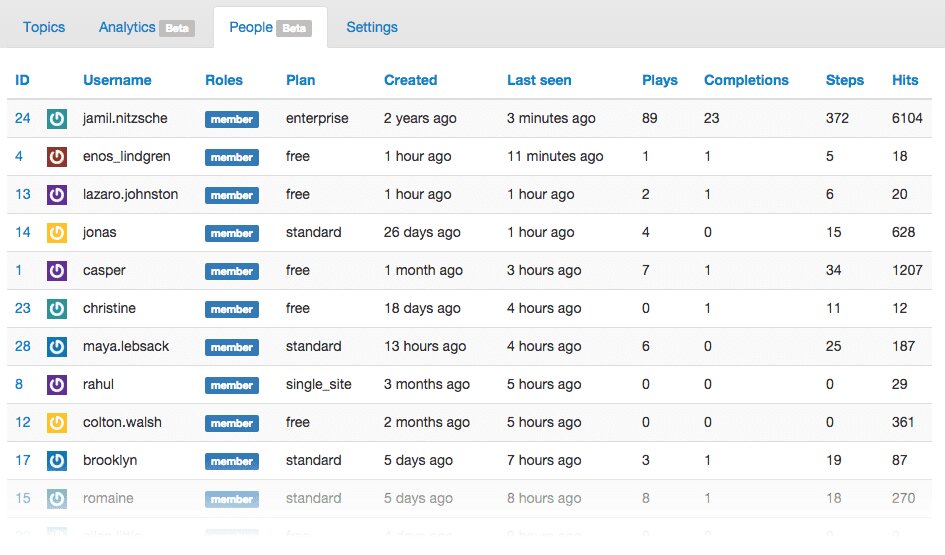
Inline Manual is a powerful SaaS onboarding software solution that empowers businesses to effectively onboard new customers. With it, businesses can easily design interactive walkthroughs, pop-ups, and tooltips that guide users through their application or website. Furthermore, the Inline Manual customer onboarding software helps create in-app guidance and onboarding materials without any coding.
It is a highly beneficial feature that allows you to store and revise various versions of your onboarding content and update it as your application evolves. This provides a systematic approach to managing changes and makes sure users have a seamless and relevant onboarding experience.
Branching is yet another powerful feature of the Inline Manual customer onboarding tool, which allows you to tailor the onboarding experience for different user paths and scenarios. With Inline Manual, businesses can present users with specific instructions based on their previous interactions or choices within your application. This way users receive relevant guidance and support as they use different features.
Users can easily share their thoughts, suggestions, and concerns directly through the Inline Manual customer onboarding platform. This input helps creators understand user perspectives and identify pain points, allowing them to make targeted improvements. Additionally, Inline Manual’s feedback mechanisms allow users to report issues, helping creators quickly address and resolve any challenges.
Inline Manual offers comprehensive and detailed analytics that provide valuable insights into user engagement and interactions with your onboarding content. You can track product usage as well as various metrics like user interactions, click-through rates, completion rates, and drop-off points within your onboarding flows. This data helps you identify which parts of your onboarding content are most effective and which might need improvement.
Pricing: Starts from $158/month.
Free trial: Available.
Capterra rating: 4.3 (3 reviews).
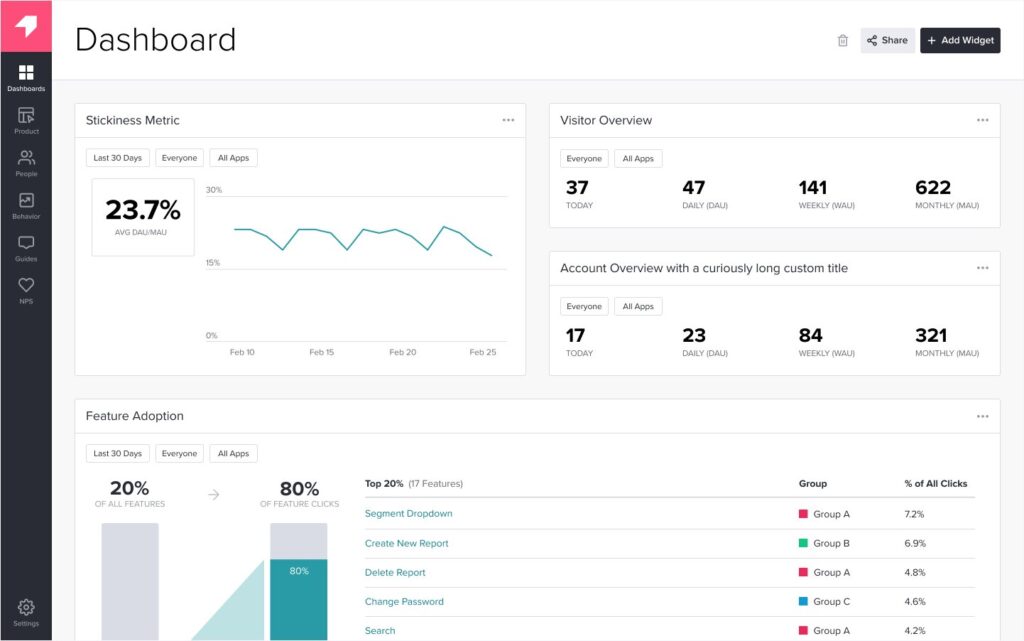
Moving forward in our list of customer onboarding software solutions, we have Pendo. It is quite a popular customer onboarding tool aimed mainly at companies producing digital products. Pendo is a no code solution with strong analytical capabilities that allow businesses to collect and analyze data on product adoption. These analytics include user behavior, feature usage and navigation patterns, which give a business a full picture of its user interactions.
Besides analytics, Pendo allows creating user onboarding content too – interactive guides, walkthroughs, and custom messaging that guide users through your product’s key features and help them quickly understand its capabilities and benefits.
Pendo can be integrated with a number of popular customer relationship management (CRM) systems, project management software, analytics platforms, and communication apps including Hubspot, Jira, BigQuery, Calendly, Drift, HelpDocs, Microsoft Teams, and Optimizely.
The platform allows gathering feedback directly within the product interface; companies can then analyze it and prioritize feature requests.
Pendo onboarding tool provides the functionality to segment users and deliver tailored in-app messages to individual user segments.
With this onboarding software, businesses can tailor onboarding experiences according to user behaviors and preferences, and send target messages, feature recommendations, and content that complies with individual user needs.
Pricing: Available upon request.
Free trial: Available.
Capterra rating: 4.5 (212 reviews).
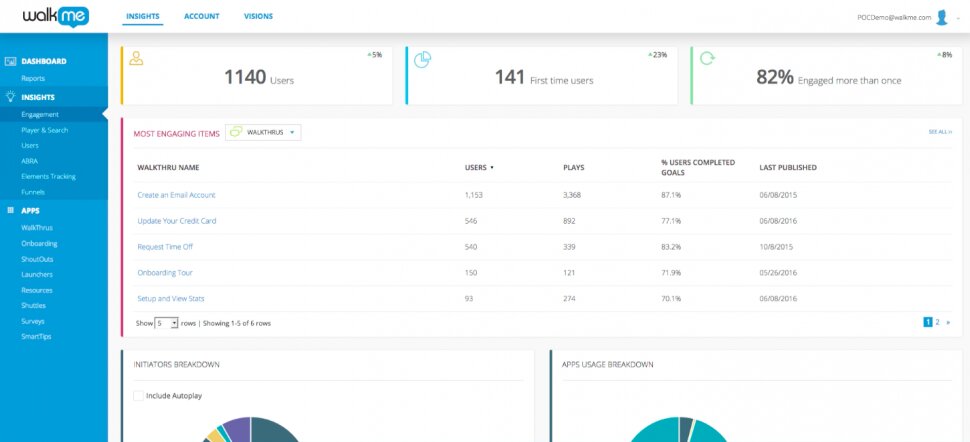
The next customer onboarding software solution we’re highlighting is WalkMe, which is a digital adoption platform used by businesses to speed up and enhance customer onboarding. Its powerful tools and features create a smoother customer journey, aid in customer engagement, and guarantee customer success.
It should be noted that the WalkMe customer onboarding software helps present the right tutorial to each new customer precisely when it is needed. This relieves users from the burden of searching through your knowledge base for information and allows companies to greatly increase user adoption rates.
WalkMe’s comprehensive analytics offer a deep dive into user interactions, enabling businesses to understand user behaviors, preferences, and pain points. These insights help make data-driven decisions and refine user onboarding processes further.
It is a standout feature that enhances user experiences by providing real-time assistance within digital interfaces. With step-by-step walkthroughs, contextual tooltips, product tours, and on-screen prompts, WalkMe guides users through complex processes, simplifying tasks and reducing user frustration. This is especially helpful for SaaS companies and subscription businesses with large user bases who need to improve user adoption.
The WalkMe onboarding software solution allows you to define user groups based on their specific attributes, actions they have performed or characteristics they possess. Further, you can tailor your content according to these user segments.
By tailoring content and guidance based on individual user attributes, behaviors and preferences, WalkMe creates a more relevant and engaging interaction. This customization ensures users receive information that directly resonates with their needs, streamlining their customer journey and increasing overall satisfaction.
WalkMe seamlessly integrates with numerous popular solutions, including but not limited to Salesforce, Google Analytics, Slack, Azure Active Directory, LiveChat, and Zendesk.
Pricing: Available upon request.
Free trial: Available.
Capterra rating: 4.4 (62 reviews).
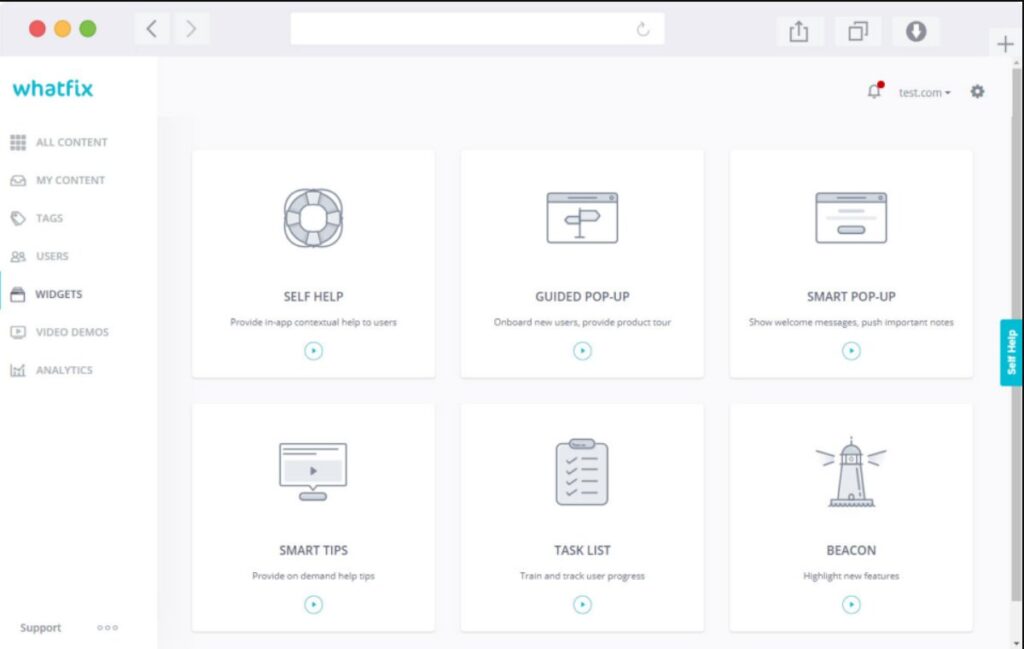
Next in line for our customer onboarding software solutions is Whatfix, which is a dynamic customer success platform that aims to streamline the onboarding experience and maximize the value of software applications. It enables businesses to deliver contextual and interactive guidance to users, helping them cope easily with complex things and processes.
With Whatfix, businesses can not only create product tours, step-by-step guides, tooltips, videos, and white papers, but also self-help widgets inside their apps, so users can access training content when it is needed and thus learn on the fly.
The Whatfix customer onboarding software is compatible with all web-based applications. Browsers that can be used for content creation include Mozilla Firefox, Google Chrome, and the new Microsoft Edge (Chromium).
Whatfix allows generating an onboarding tasks list within your application for new users to accomplish, which allows them to get to know the app steadily and monitor their advancement.
Whatfix’s Self-Help feature enables businesses to establish an in-app, searchable wiki that seamlessly integrates with company FAQs, documentation, video tutorials, knowledge base, and other resources. This functionality offers users immediate access to relevant help content precisely when they need it, enhancing the customer experience and support process.
Whatfix offers robust multilingual support, enhancing user experiences by providing content and guidance in a variety of languages. This feature ensures that users from different regions and linguistic backgrounds can access onboarding materials and support resources in their preferred language.
Pricing: Available upon request.
Free trial: Available.
Capterra rating: 4.6 (76 reviews).
Onboarding is not simply telling your customers how to use your product or service. For this, documentation exists. The customer or client onboarding process is something much more complex – it requires a package approach, joint effort of various teams and, of course, the right tools. When onboarding your new customers effectively, you can increase customer retention, raise customer happiness and boost sales in the long-term.
In today’s super digital world, it would be unwise for small or medium-sized businesses to ignore the advantages offered by technology. And that is true for every aspect of a business, not only customer onboarding.
In this article, we compiled a list of the best client and customer onboarding software tools and digital adoption platforms to use. We thoroughly analyzed the strengths, key features, rankings and pricing options of the shortlisted tools. Out of seven onboarding software solutions mentioned in the article, FuseBase seems to be the best value for money.
Discover from our experts the best way to manage the onboarding process
Want to improve your client onboarding experience and establish right customer onboarding flows? Take the first step by trying out FuseBase today.
Disclaimer
Parties other than FuseBase may provide products, services, recommendations, or views on FuseBase site (“Third Party Materials”). FuseBase is not responsible for examining or evaluating such Third Party Materials, and does not provide any warranties relating to the Third Party Materials. Links to such Third Party Materials are for your convenience and do not constitute an endorsement of such Third Party Materials.
Found it useful? Share the article with your community
Get weekly tips and insights on how to grow your business